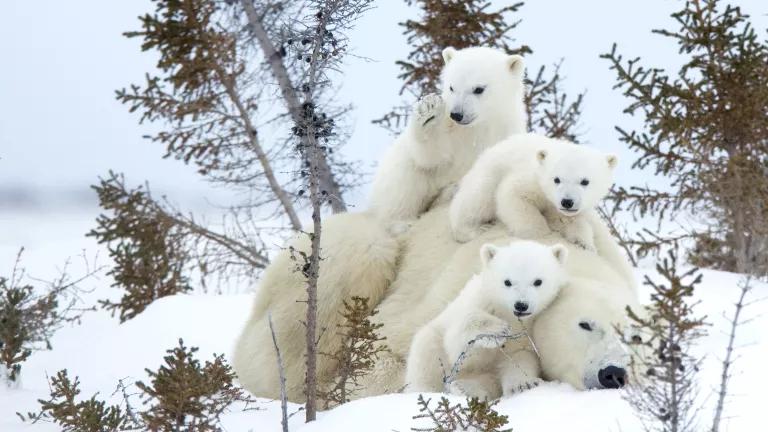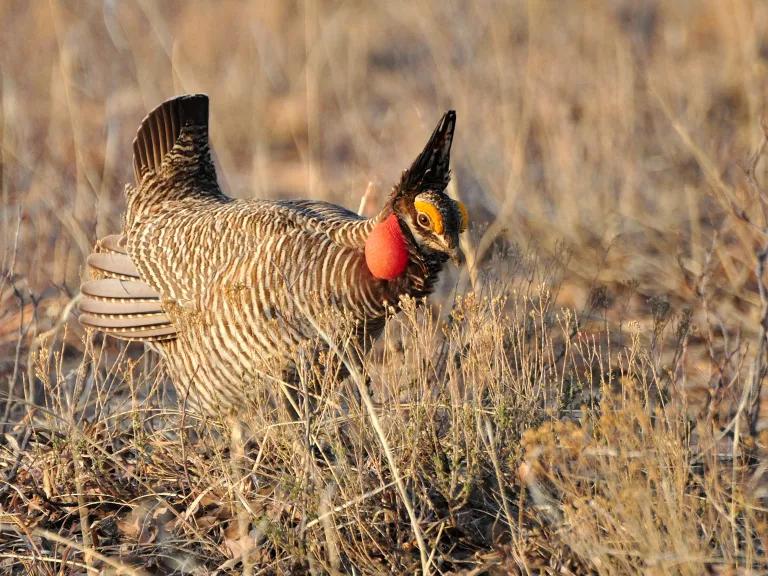Federal Agencies Restore Endangered Species Protections—Mostly
U.S. FWS and NMFS proposed to reverse prior rollbacks of protections for imperiled species, but more is needed.

A mother polar bear, listed as threatened under the ESA, resting as her three cubs climb over her in Wapusk National Park, Manitoba, Canada.
The U.S. Fish and Wildlife Service and National Marine Fisheries Service (“Services”) released a set of proposed rules that restore protections for species listed under the Endangered Species Act. The much-anticipated rules are a rollback of the Trump administration’s 2019 package of rules that undermined core protections for listed species and their habitat. While the new rules reverse many of those harmful changes, they also leave in place key changes that weaken our nation’s most important—and successful—wildlife-protection law.
First, the good. The new regulations restore crucial protections in a number of ways, but three stand out:
- They restore automatic protections for threatened species. For decades, when the Fish and Wildlife Service listed a species as threatened, they automatically gave it the same protections as endangered species unless the agency developed species-specific protections. In other words, full protections were the default. But in 2019, the Trump administration did away with this practice; if FWS listed a threatened species and did not promulgate specific protections, the species would receive no protections from hunting, trapping, and other harms. With these changes, the Services have restored default protections, ensuring that species get the protection they need and creating less work for an already over-burdened agency.

An endangered lesser prairie-chicken walking through scrub.
- They ensure that listing decisions are based on science, not money. The ESA clearly prohibits the Services from considering economic factors when deciding whether a species should be listed. Instead, that determination is to be based solely on the biological needs of the species. Nevertheless, the 2019 rules deleted that limitation from the Services’ regulations, suggesting that economic factors would be allowed to infect these crucial decisions. The new rules restore the requirement, ensuring that decisions are made based on science, consistent with the Act.
- They make it easier to consider future threats to species. The 2019 regulations created a new requirement that made it harder to list species based on predictions of future harm. For example, it would have made it harder to protect a species that is threatened by future effects of climate change, like sea ice loss or rising sea levels. The new regulations do away with this unnecessary requirement, allowing the Service to protect and help species before it is already too late.
Now, the not-so-good. The regulations fail to repeal some significant, harmful changes enacted in 2019. For example:
- They continue to allow piecemeal destruction of habitat. “Critical habitat” is one of the foundational protections under the ESA. These are designated areas of especially important habitat that are protected from federal actions that would destroy them. In 2019, the Services newly allowed federal actions to destroy critical habitat if the action did not significantly decrease the value of critical habitat “as a whole.” This makes it easier to approve incremental destruction of these crucial areas, eventually resulting in “death by a thousand cuts.”

A threatened northern spotted owl sitting on an ash tree branch in Oregon.
iStock
- They continue to limit the scope of review for federal actions that harm species. The ESA requires all federal agencies to ensure that their actions do not drive species toward extinction. But federal actions are often complicated, setting off a chain of events with the potential to harm species. For example, approving a logging project might in turn require the building of a new road to transport lumber, an increase in truck traffic, and a resulting reduction in air quality in the region. It’s critical that all of these impacts are considered, but the 2019 rules limited the extent that agencies had to consider these indirect effects. Those rules are largely untouched by the most recent changes.
As the biodiversity and climate crises rage, it is absolutely imperative that the Services use all the tools at their disposal to protect and recover our most imperiled species. In the fifty years since Congress passed the ESA, the Act has saved 99% of the species under its care from extinction. To celebrate the Act’s 50th anniversary, we should be strengthening the ESA more than ever—not allowing its protections to fall by the wayside. That is why NRDC will be urging the Services to finalize their proposed rules, and go further to fully restore ESA protections to their historical strength. Check back for updates on how to make your voice heard.




